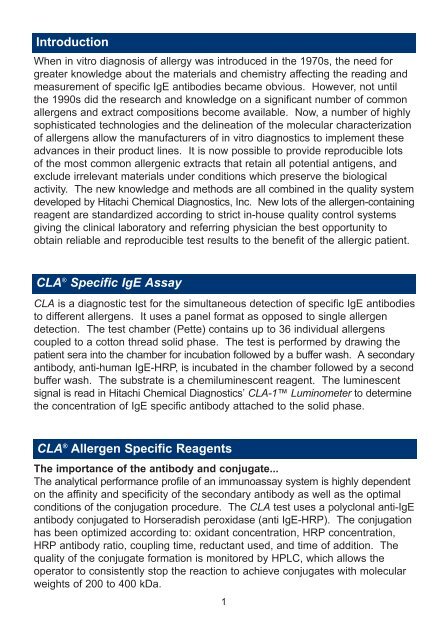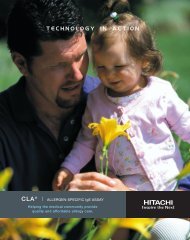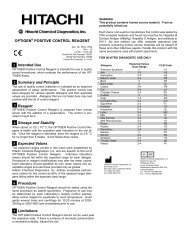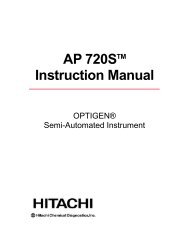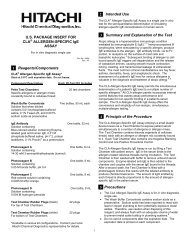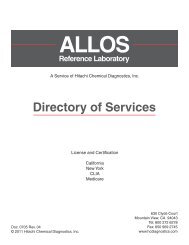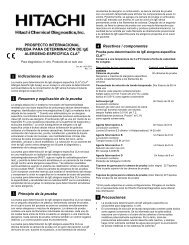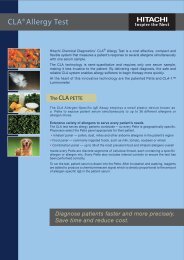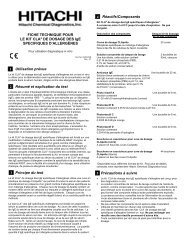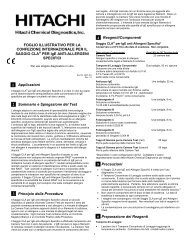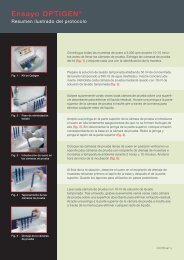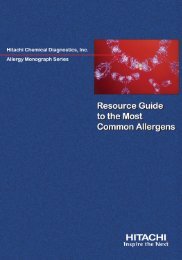Allergen Standardization Program - Hitachi Chemical Diagnostics
Allergen Standardization Program - Hitachi Chemical Diagnostics
Allergen Standardization Program - Hitachi Chemical Diagnostics
Create successful ePaper yourself
Turn your PDF publications into a flip-book with our unique Google optimized e-Paper software.
Introduction<br />
When in vitro diagnosis of allergy was introduced in the 1970s, the need for<br />
greater knowledge about the materials and chemistry affecting the reading and<br />
measurement of specific IgE antibodies became obvious. However, not until<br />
the 1990s did the research and knowledge on a significant number of common<br />
allergens and extract compositions become available. Now, a number of highly<br />
sophisticated technologies and the delineation of the molecular characterization<br />
of allergens allow the manufacturers of in vitro diagnostics to implement these<br />
advances in their product lines. It is now possible to provide reproducible lots<br />
of the most common allergenic extracts that retain all potential antigens, and<br />
exclude irrelevant materials under conditions which preserve the biological<br />
activity. The new knowledge and methods are all combined in the quality system<br />
developed by <strong>Hitachi</strong> <strong>Chemical</strong> <strong>Diagnostics</strong>, Inc. New lots of the allergen-containing<br />
reagent are standardized according to strict in-house quality control systems<br />
giving the clinical laboratory and referring physician the best opportunity to<br />
obtain reliable and reproducible test results to the benefit of the allergic patient.<br />
CLA ® Specific IgE Assay<br />
CLA is a diagnostic test for the simultaneous detection of specific IgE antibodies<br />
to different allergens. It uses a panel format as opposed to single allergen<br />
detection. The test chamber (Pette) contains up to 36 individual allergens<br />
coupled to a cotton thread solid phase. The test is performed by drawing the<br />
patient sera into the chamber for incubation followed by a buffer wash. A secondary<br />
antibody, anti-human IgE-HRP, is incubated in the chamber followed by a second<br />
buffer wash. The substrate is a chemiluminescent reagent. The luminescent<br />
signal is read in <strong>Hitachi</strong> <strong>Chemical</strong> <strong>Diagnostics</strong>’ CLA-1 Luminometer to determine<br />
the concentration of IgE specific antibody attached to the solid phase.<br />
CLA ® <strong>Allergen</strong> Specific Reagents<br />
The importance of the antibody and conjugate...<br />
The analytical performance profile of an immunoassay system is highly dependent<br />
on the affinity and specificity of the secondary antibody as well as the optimal<br />
conditions of the conjugation procedure. The CLA test uses a polyclonal anti-IgE<br />
antibody conjugated to Horseradish peroxidase (anti IgE-HRP). The conjugation<br />
has been optimized according to: oxidant concentration, HRP concentration,<br />
HRP antibody ratio, coupling time, reductant used, and time of addition. The<br />
quality of the conjugate formation is monitored by HPLC, which allows the<br />
operator to consistently stop the reaction to achieve conjugates with molecular<br />
weights of 200 to 400 kDa.<br />
1


